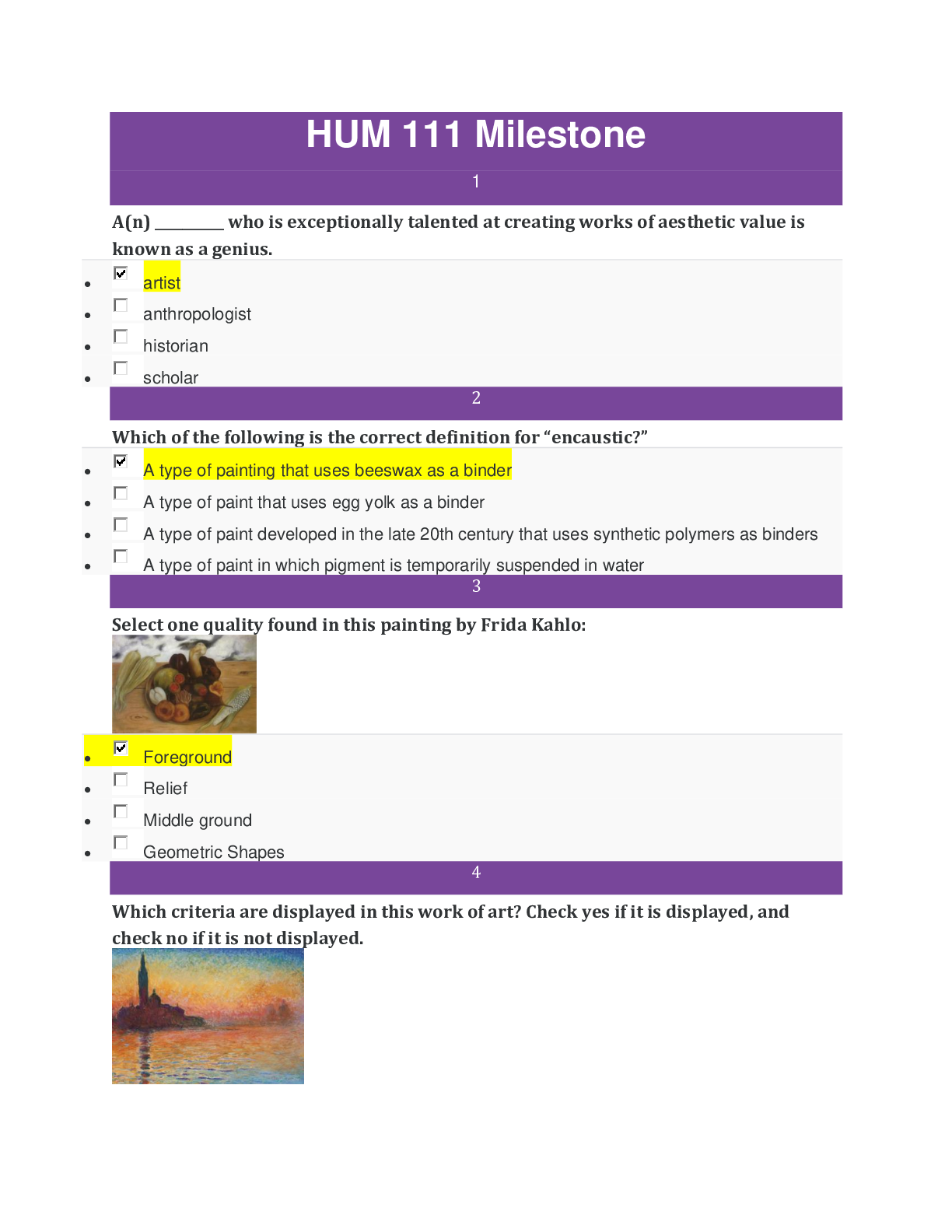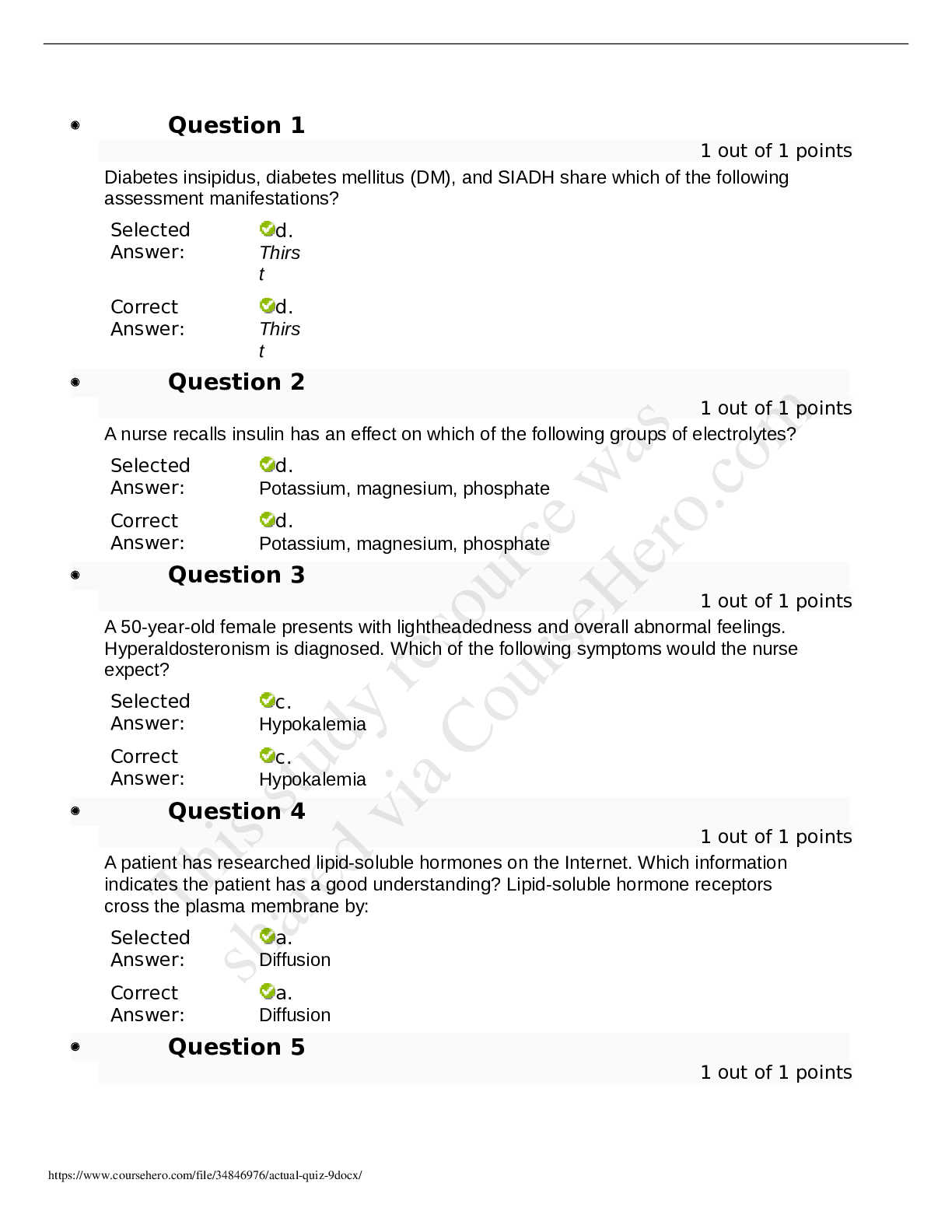Biology > QUESTIONS & ANSWERS > BIOS 1108 IKE, TICA, HW questions and answers, 2022/2023. 100% verified. (All)
BIOS 1108 IKE, TICA, HW questions and answers, 2022/2023. 100% verified.
Document Content and Description Below
BIOS 1108 IKE, TICA, HW questions and answers, 2022/2023. 100% verified. one target cells can express the hormone recpetors - ✔✔The reason a particular hormone only affects specific target ce... lls in the body is that: endocrine neuroendocrine - ✔✔Adrenaline is produced by neurons in your brain and can cause changes in blood flow, heart rate, and respiratory rate. Adrenaline could be classified as a?? Steroids are lipid soluble and readily cross plasma membranes, while polypeptide and most amino-acid derived hormones cannot - ✔✔Why are the structural differences among amino-acid derivative(structurally derived from amino acids), polypeptide(small proteins), and steroid hormones significant? the signal is transmitted inside the cell in another form - ✔✔When a signaling molecule binds to a receptor at the cell membrane, it gets transduced. What is meant by the term "signal transduction"? the steroid hormone repeatedly activates transcription of target genes each mRNA copy of a steroid-hormone target gene can be translated into protein multiple times - ✔✔How is the signal from a steroid hormone amplified? the product of a process inhibits its production - ✔✔Negative feedback is defined as __________ would be useful as an antibiotic would prevent biofilm formation would prevent bacterial virulence - ✔✔A drug that disrupts (prevents) bacterial quorum sensing(select all that apply)? pancreas - ✔✔Which of these glands is located within the abdominal cavity? glucagon - ✔✔analysis of a blood sample from a fasting individual who had not eaten for twenty-four hours would be expected to reveal high levels of ______? adrenal medullla, leading to an increased secretion of epinephrine - ✔✔Fight- or flight reactions include the activation of the_________???, leading to ________??? only specific cells express the receptors for particular hormones - ✔✔The response to a hormone is tissue-specific because________? the product of a process inhibits its production - ✔✔Negative feedback is defined as_________? high insulin, low glucagon - ✔✔Shortly after ingesting a big plate of carbohydrate-rich pasta, you measure your blood's hormone levels. What results would you expect, compared to before the meal? decreases food consumption by signaling "satiation" -secreted by adipose(fat) cells. the amount secreted is proportional to the amount of fat cells present. -higher leptin levels are interpreted by the brain to indicate adequate fat stores and suppress appetite. -low leptin levels indicate inadequate fat stores and stimulate appetite. -the brain can adapt to high levels of leptin and interpret them as "normal", making weight loss difficult - ✔✔What does the hormone leptin do? arrested development - the prothoracic gland releases ecdysone, which is the hormone signaling molting or metamorphosis. Without this, a larva is likely stuck in an early larval stage, even as juvenile hormone levels change. This ultimately likely fatal to the insect - ✔✔What would happen if you surgically removed the prothoracic gland of a developing insect larva? All are most active during "juvenile" stage -early life, such as an egg stage, does not display these hormones for these organism(in fact, having them too early may development proceed too quickly and leave some organs underdeveloped). Metamorphosis is changing the body structure, so although this happens in many amphibians and insects, its not true for all animals. Similarly these hormones don't all signal growth to greater size, but toward a more adult/final form. All are most active in the juvenile stage - ✔✔How are T3, HGH, and JH similar? adrenal medulla, leading to increased secretion of epinephrine - ✔✔Fight-or flight reactions include the activation of the hypothalamus integrates nervous and endocrine systems hypothalamus produces oxytocin and antidiruretic hormones anterior pituitary releases adrenocorticotropic, follicle stimulating, prolactin, thyroid-stimulating, and other hormones that are released into blood vessels to act on another tissue; these hormones are also produced by this structure posterior pituitary is an extension of the hypothalamus which stores the hormones produced by the hypothalamus posterior pituitary releases oxytocin and antidiuretic hormones; these hormones are produced by another structure anterior pituitary is a separate structure from the hypothalamus and regulated by hormones released by the hypothalamus -anterior pituitary produces and secretes hormones in response to stimulation from the hypothalamus. in contract, the posterior pituitary is an extension of the hypothalamus which serves as storage for ADH and oxytocin produced by the hypothalamus, look at figure 49.13 for more information - ✔✔Match the phrase to the appropriate brain structure? hypothalamus integrates...... hypothalamus produces... anterior pituitary releases.... posterior pituitary is.... posterior pituitary releases.... anterior pituitary is.... auxin... leaf abscission; apical dominance; phototropic response; gravitropic response cytokinins...cell division gibberellins... stem elongation; seed germination; fruit growth jasmonic acid...defense against herbivory abscissic acid... seed dormancy; bud dormancy inhibits cell division ethylene... fruit ripening;leaf abscission methyl salicylate... defense againsts pathogens - ✔✔Match the plant hormone to its primary function: auxin... cytokinins.... gibberellins... jasmonic acid... abscissic acid... ethylene... methyl salicylate... auxins, gibberellins, cytokinins -auxins are produced in apical meristems and are master regulators of plant growth -gibberellins promote plant growth, but only in the presence of auxin cytokinins promote cell division(which leads to growth), but only in the presence of auxin - ✔✔if a plant failed to grow taller, which of the following hormones might you artificially add to stimulate growth(select all) regulates dormancy, both in the seed(prevents germination) and in the photosynthetic tissue(closes guard cells of stomata in response to drought) - ✔✔What does abscisic acid do? promotes senescence(aging), both in fruit (ripening) and in leaf abscission (falling off of dead leaves in fall/winter) - ✔✔What does ethylene do? auxins - auxin is the main regulator of plant growth, including bending toward light and gravity. the response is due to the asymmetric distribution of auxin in response to the angle of the blue light. auxin is produced constantly at the apical meristem, but its distribution is affected by the angle of blue light. the auxin redistributes toward the shaded side of the plant, causing differential cell expansion and thus causing bending toward the light - ✔✔Blue light induces the phototropic response. It does so through which hormone? far-red light -far-red light is the some of the only light that passes through leaves. thus if a plant is receiving primarily far-red light and not other wavelengths, this indicates that the plant is growing under other plants - ✔✔Which of the following signals indicated shade to a plant? gibberellins -in the adult plant, gibberellins promote plant growth, but only in the presence of auxin. they are also involved in fruit. they also regulate germination of seeds in response to water imbibition. specifically causing increased production of the enzyme amylase that breaks down starch into sugars to promote seedling germination and growth - ✔✔Red light induces germination, Which hormone also contributes to germination(through a different mechanism)? redistribution of auxin to the bottom side of a growing root in response to gravity the movement of statoliths altering the distribution of auxin the roots -auxin promotes bending in roots as in shoots, but through a totally different mechanism. in shoots, auxin redistributes to the shaded side of the plant where it promotes differential cell elongation, thus causing the plant ot bend toward the light. the mechanism of auxin's role in phototropism is well understood and is called the acid growth hypothesis" in contrast, in roots auxin is redistributed to the bottom side of the root where it seems to inhibit cell elongation, thus causing the root to bend toward gravity, the mechanism for this process is not well understood - ✔✔gravitropism in roots is mediated by 1)systemin, 2)jasmonic acid, 3)proteinase inhibitors -systemin is released in response to herbivory, and is transported throughout the plant in the vascular tissue(it is named systemin for the fact that it become systemically distributed) in response to systemin, proteinase inhibitors are produced which interfere with herbivore digestion and taste bad -MeSA and phytoalexins are involved in the pathogen response (MeSA in the SAR and phytoalexins in the HR) - ✔✔Herbivory on one leaf of a plant results in changes in gene expression in the whole plant to protect against additional herbivores, This response is initiated by__________1)?______ secreted by the damaged cells, results in production of _______2)?_______ in undamaged cells which leads to expression of ___________3)?_______ throughout the entire plant to make the herbivore sick neither the HR nor the SAR response will be induced -the HR occurs first, in response to a specific pathogen, the activity of the HR induces the SAR, which is systemic and nonspecific, the HR is pathogen-specific, and thus relies on the plant first recognizing that there is a particular pathogen present, through identification of pathogen specific molecules, If this step does not occur, because the plant does not recognize the pathogen, the plant cannot defend against the pathogen and neither the HR nor the SAR will be induced - ✔✔the HR response is pathogen-specific through specific plant receptors that recognize specific pathogens. If a plant is attacked by a pathogen that it does not recognize (has no receptors for), which of the following will occur? 1?MeSA; 2?pathogenesis-related genes - ✔✔Pathogen infection in one leaf of a plant results in changes in gene expression in other leaves to protect against the spread of the pathogen. This general response is mediated by ____1?_____ and results in production of _____2?_______ to kill or inactivate the pathogens The stem will bend to the left -phototropins are proteins that detect blue light, the signal which causes phototropism. the response (bending) is due to the asymmetric distribution of auxin in response to the angle of the blue light. auxin is produced constantly at the apical meristems, but its distribution is affected by the angle of blue light. the auxin redistributes toward the shaded side of the plant, causing differential cell expansion and thus causing bending toward the light. In this experiment, the auxin in the cut shoot diffused into the agar block, so the agar block was full of auxin, because the block was placed only only on one side of the cut shoot, the auxin diffused only into that side of the shoot, thus causing the shoot to bend "away from" the side with the agar block - ✔✔To test whether light is required for bending, the tip of a plant was cut, placed on an agar(jelly) block, and time was given for the light-responsive hormone to diffuse into the agar block. This means there is now a high concentration of light-responsive hormone in the agar block. The agar block was then placed offset on the cut stem in the dark. What will happen? Plants use phototropins to receive a blue-light signal Asymmetric auxin distribution causes differential cell elongation that causes bending - ✔✔Plants bend towards light in a process called phototropism. Which of the following is true of this process? not germinate, because far-red light was the last light they were exposed to - ✔✔Seeds exposed to red, then blue, then red, then far-red light will: red light- indicates full sun and thus good growth conditions, so the seed would germinate - ✔✔What does red light do? near the root or shoot apical meristem -auxin is the main regulator of plant growth and is produced in the apical meristems in the roots and shoot - ✔✔Auxin plays a role in many plant functions. According to a recent hypothesis, auxin's overall role may be to signal where cells are in a plants body. If this is the case, then a high concentration of auxin would indicate that a cell is: gibberellins then ethylene - ✔✔As a vinyard manager [Show More]
Last updated: 2 years ago
Preview 1 out of 27 pages

Buy this document to get the full access instantly
Instant Download Access after purchase
Buy NowInstant download
We Accept:

Also available in bundle (1)
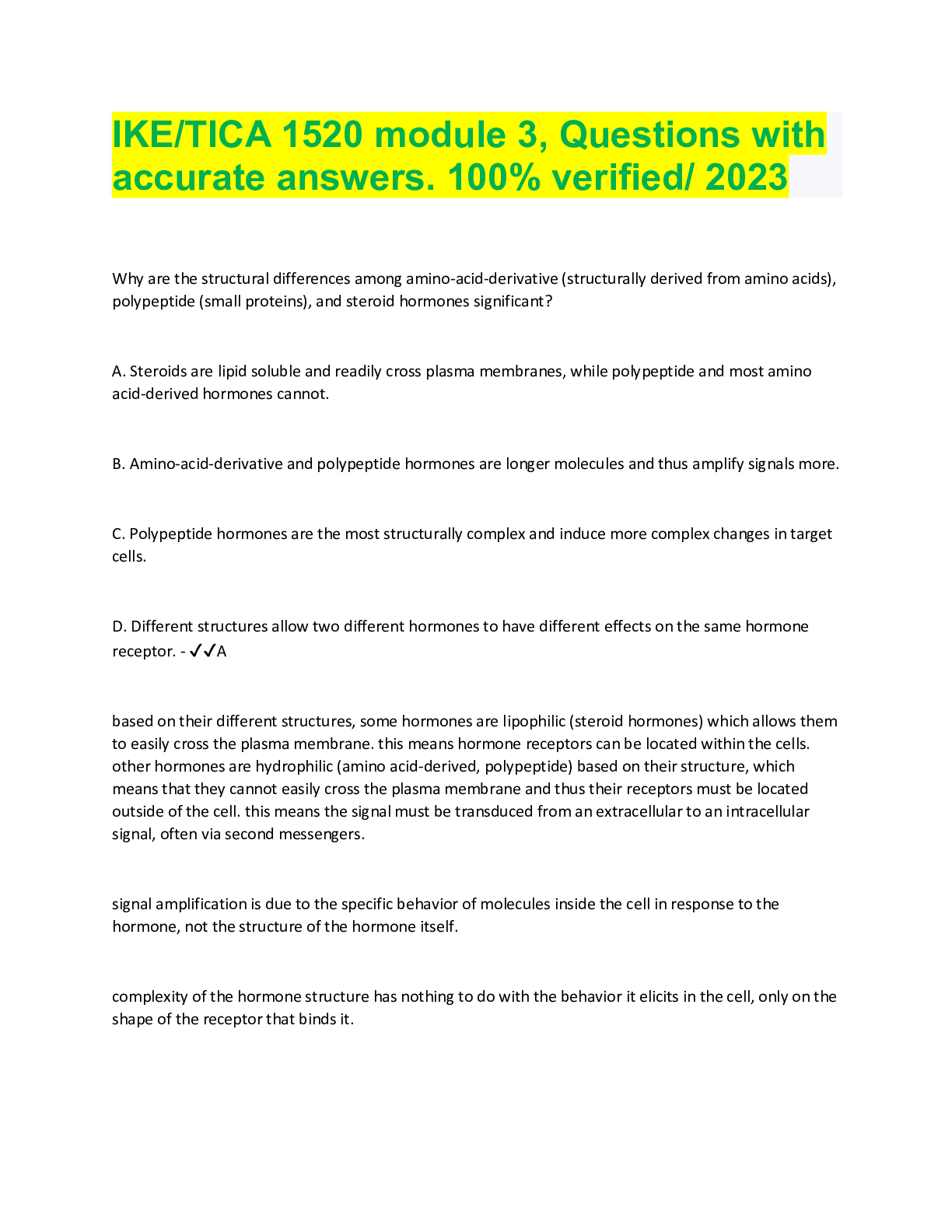
IKE/TICA All modules questions and answers. latest updates. rated A
All you need to pass the IKE/TICA All modules questions and answers. latest updates. rated A.
By Topmark 2 years ago
$30
14
Reviews( 0 )
$10.00
Can't find what you want? Try our AI powered Search
Document information
Connected school, study & course
About the document
Uploaded On
Oct 12, 2022
Number of pages
27
Written in
Additional information
This document has been written for:
Uploaded
Oct 12, 2022
Downloads
0
Views
129

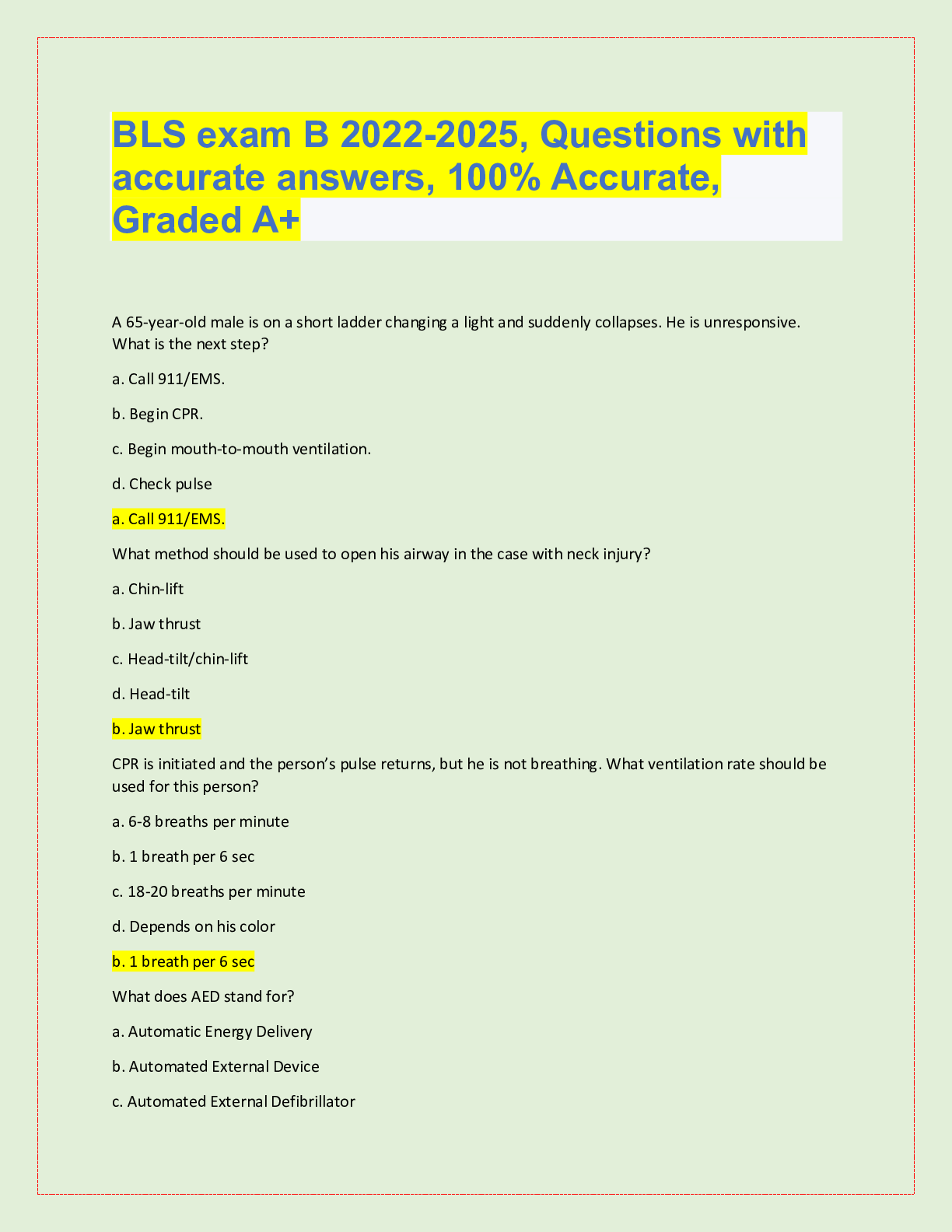











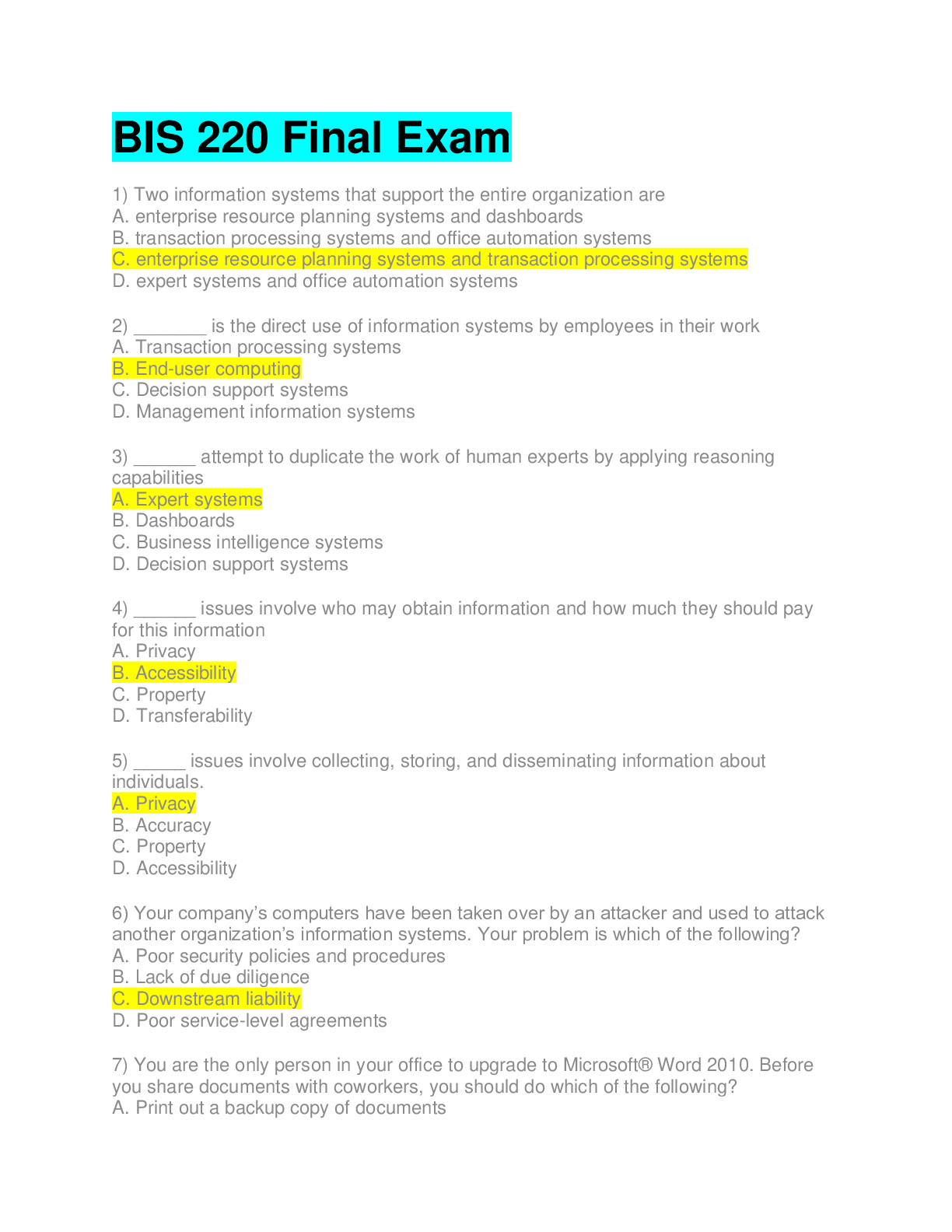
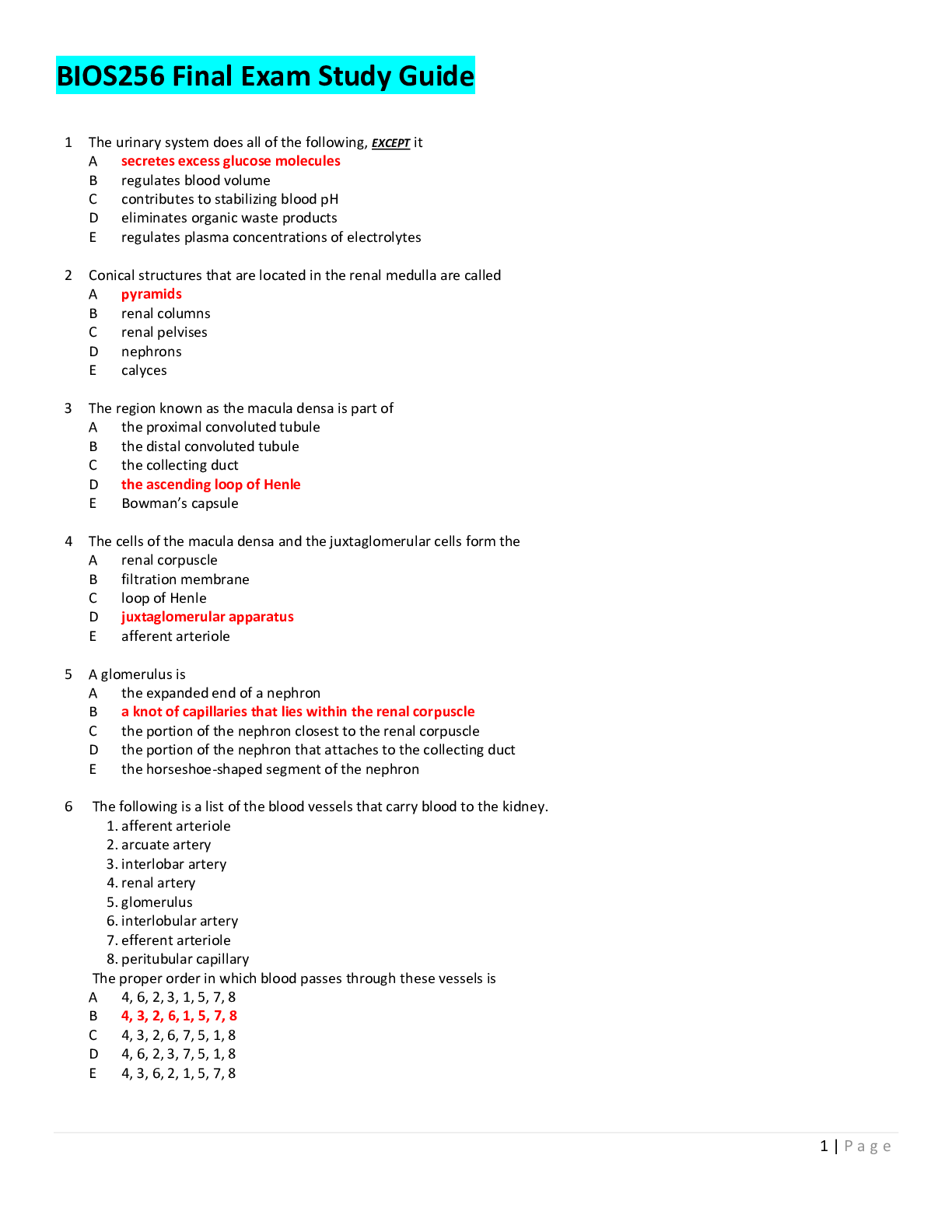


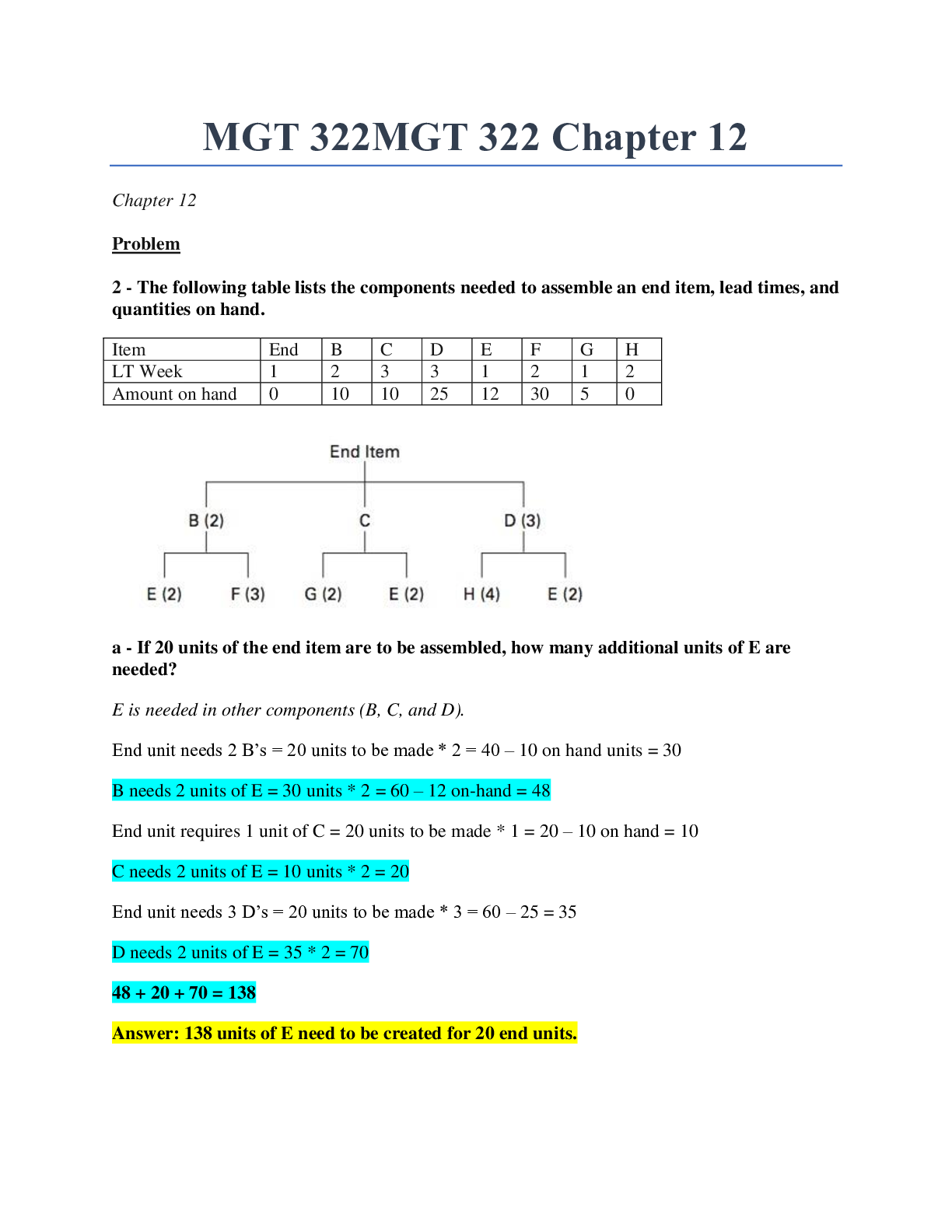
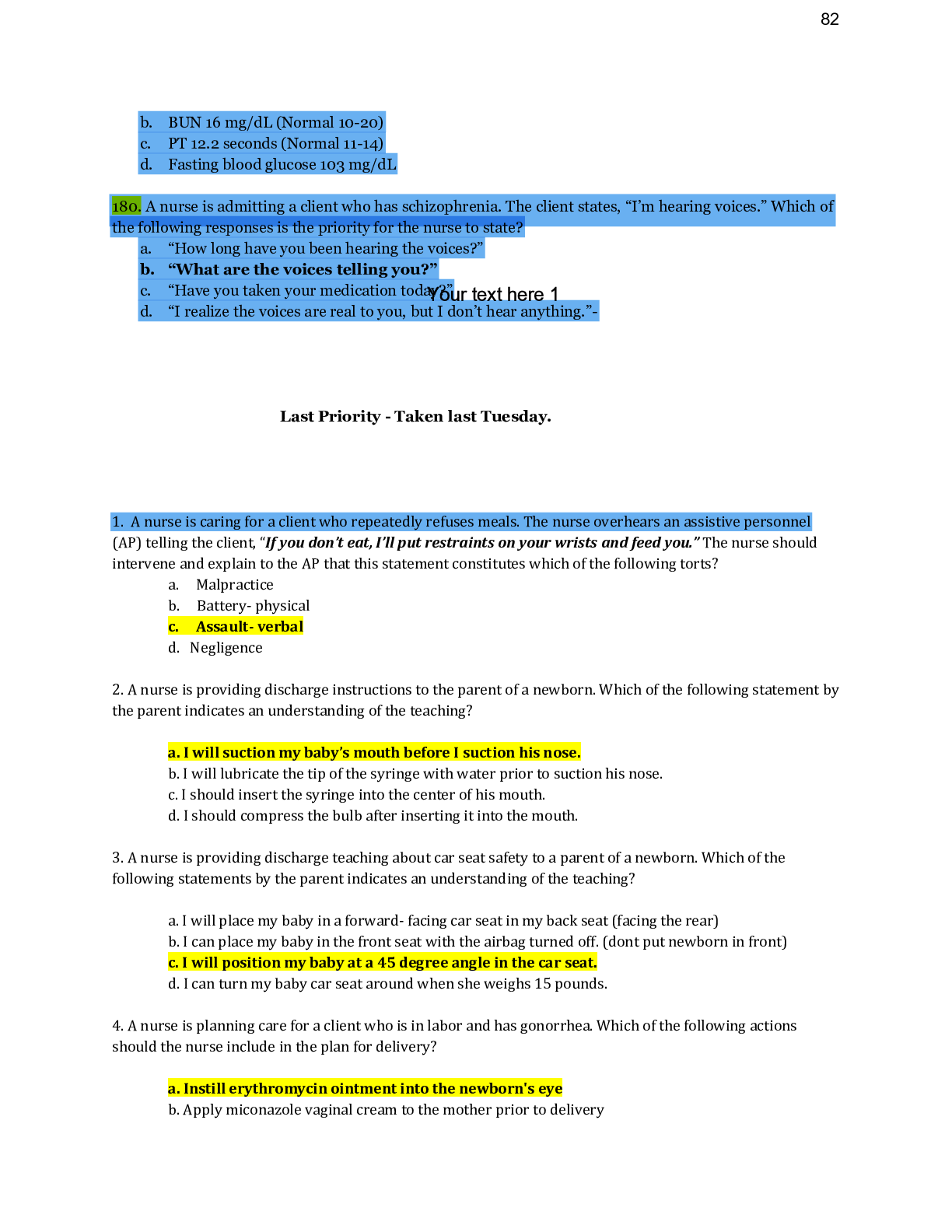
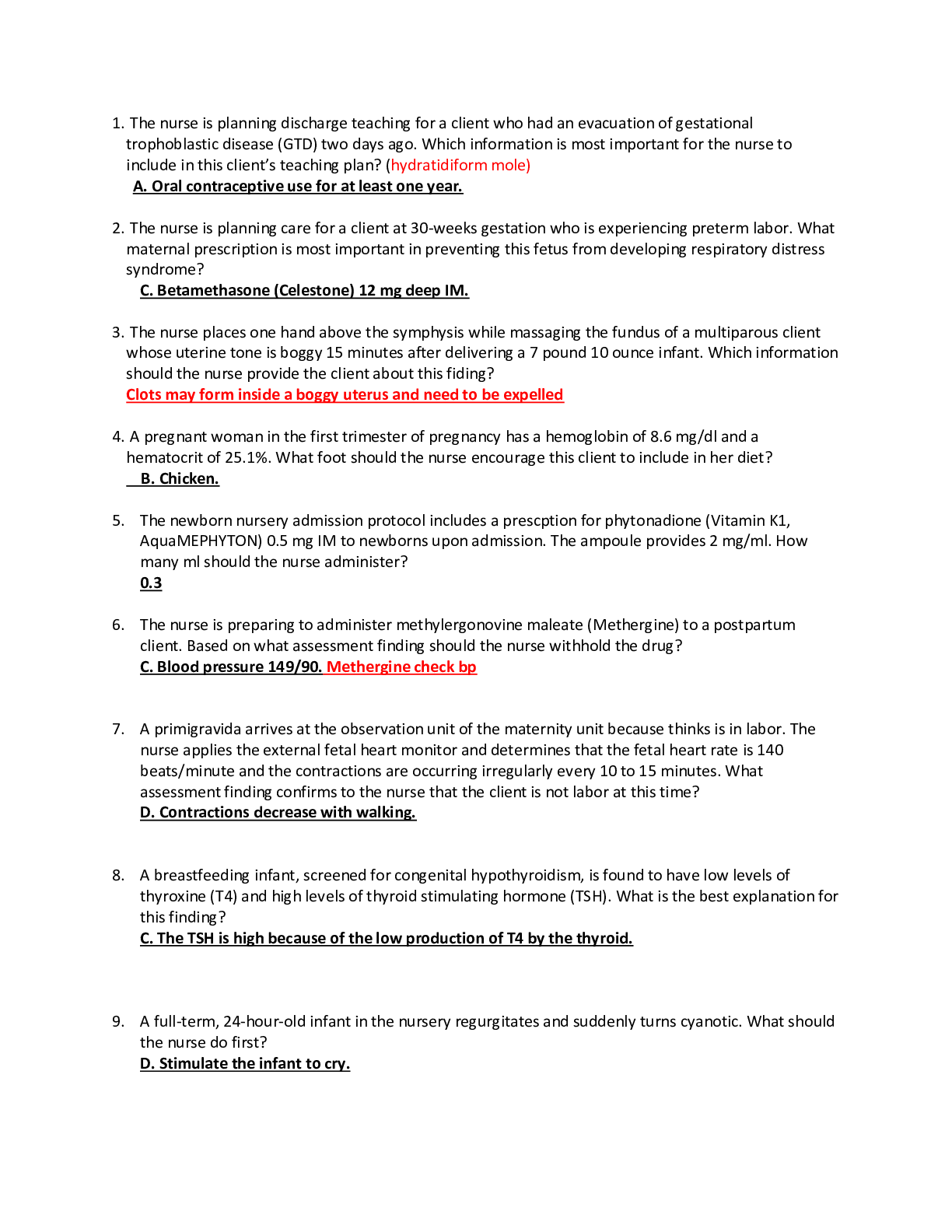
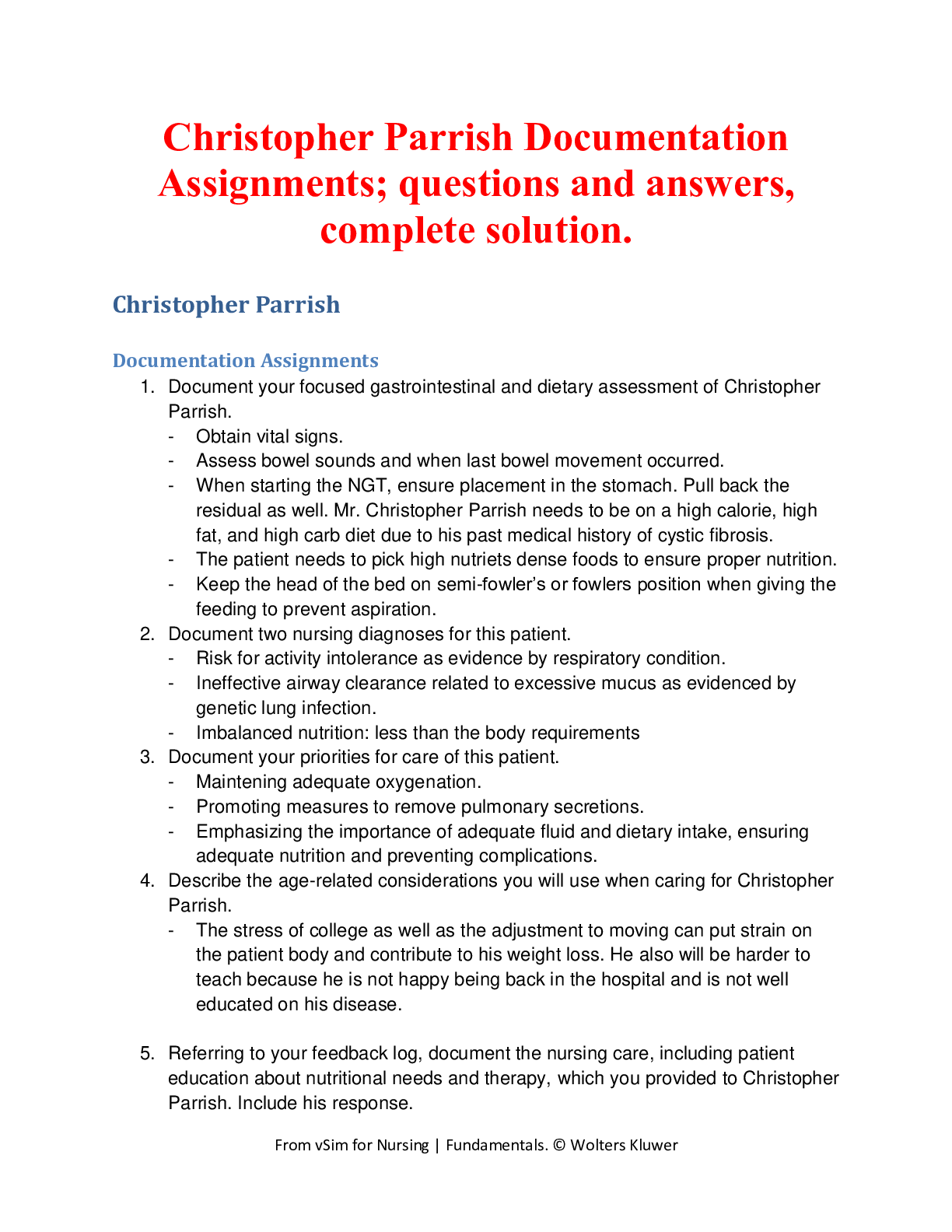
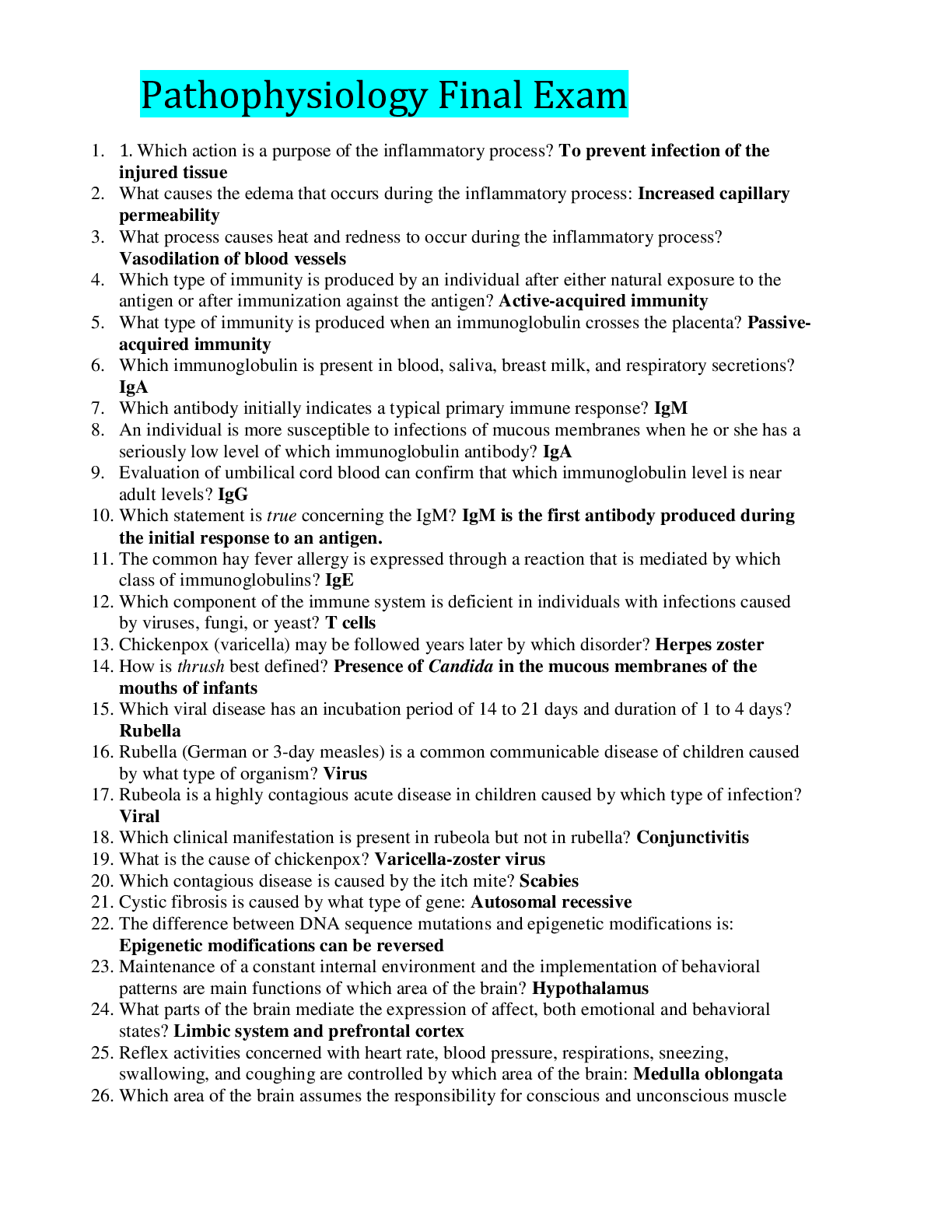
.png)
